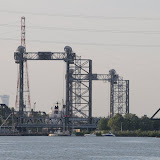
So this week we sailed off the face of the known earth! Perhaps our travels have not been on the same scale as those of Christopher Columbus or Ferdinand Magellan, they have been truly voyages of personal discovery.
We had received so many warnings about the locks that we were both pretty apprehensive about the upcoming experience. All of the guide books tell us that we chould obtain the Canadian Government Publication - The St. Lawrence Seaway Pleasure Craft Guide. In it there are comprehensive descriptions of light signals, instructional signage, fees and tying up procedures. Since the price of the book is free, I guess we can't really complain too much, but much of the information in the book is either incomplete or wrong!!
Here's the stuff that is correct:
- The light signals - seem to be used most of the time. Red for stop, Green for Go, flashing yellow to give a count down time to lock being ready.
- The bridge signals - most accurate of the signals
- Commercial traffice comes first. If you hit the seaway on a busy day, your turn is when all of the commercial ships have transited, even if a commercial vessel arrives at seemingly the last minute. Pleasure craft are tolerated, but they would not miss us if we decided not to show up.
- The location of the pleasure boat docks, and the direction of tying up at the pleasure boat docks. The challenge is to remember that you as the skipper understand more about how your boat handles at low low speeds and in tight quarters so dock accordingly, and not just because the book says use a starboard tie.
- Do check in by telephone using the call box on the dock, if you land at the pleasure craft dock, otherwise follow the leader.
- The order for entry in the lock is power boats first, sailboats second, with the largest of each type going first. In the US locks, rafting is only done when the positions on the side of the locks are filled. In the Canadian locks, everybody rafts.. power to power, sail to sail with the largest of each along the wall.
- The tie within the lock is specified in the booklet. Most are starboard, but Beauharnois locks are Port.
Here's the stuff that is wrong or incomplete:
- The fees are $25 per lock for Canada and $30 per lock for the US. In local currency of course.
- The ticket dispensers are more trouble than they are worth. Just have cash ready to hand to the lockmaster in each lock. exact change is helpful, otherwise you have to cling to the wall while they are making change....slowly.
- The sign boards that are supposed to give "clear instructions" in both official languages, are about 24x36 inches and the words scroll from right to left. They are not visible from the water so you must dock to see them, and they contain a minimal amount of useful information....in both official languages. Do not expect signs like the airport signs in the Western Gap, the Compass highway signs or the Jumbotron. Think more like the signs that show the weekly 649 prize at the local lottery kiosk. As for the information, they basically tell you to stay with your boat and wait for the lock master to yell at you through loudspeakers. The sound is about as clear as the station announcmemnts on the subway!
- Contact the US locks on channel 12 VHF and announce your arrival time at the lock. The US will actually answer your radio call and give you some decent instruction on your locking through times and procedures. Call sign is "Seaway Eisenhower", no matter which direction you are going in. Canada provides illuminated sign boards in both official languages and do not seem to have radios.
- In the US locks, have two lines long enough to run from midship to either the bow or stern and back to midship. Lighter lines are easier to handle than heavy and you won't need to tie tightly. The lines are more for steadying the boat than anything else. Canada provides lines of triple strand polyester to the inside boat of the raft. everybody else uses their own lines.
At the end of the day, locking through is a bit of a non event. Once you've done one lock, the rest are pretty much the same. Just don't expect to be marshalled with any degree of precision and you'll be fine. There are obviously some procedures that have been developed to handle pleasure boats, but they should be considered as guidelines and not as the abosolute law. Just use common sense and the locks will not be a problem.
Panama here we come!!!!
 |
| Locks - click on the image for more pictures |






No comments:
Post a Comment